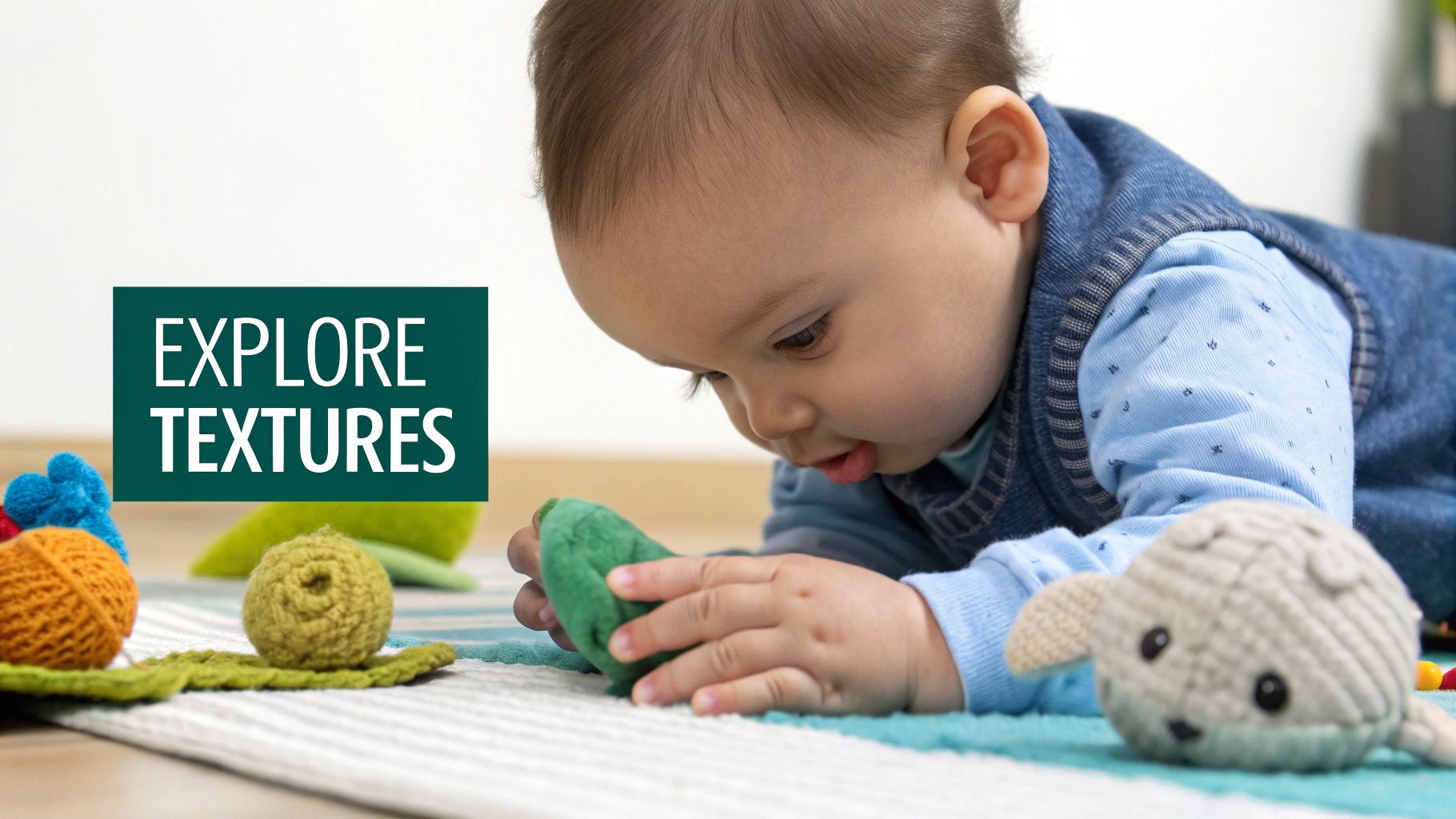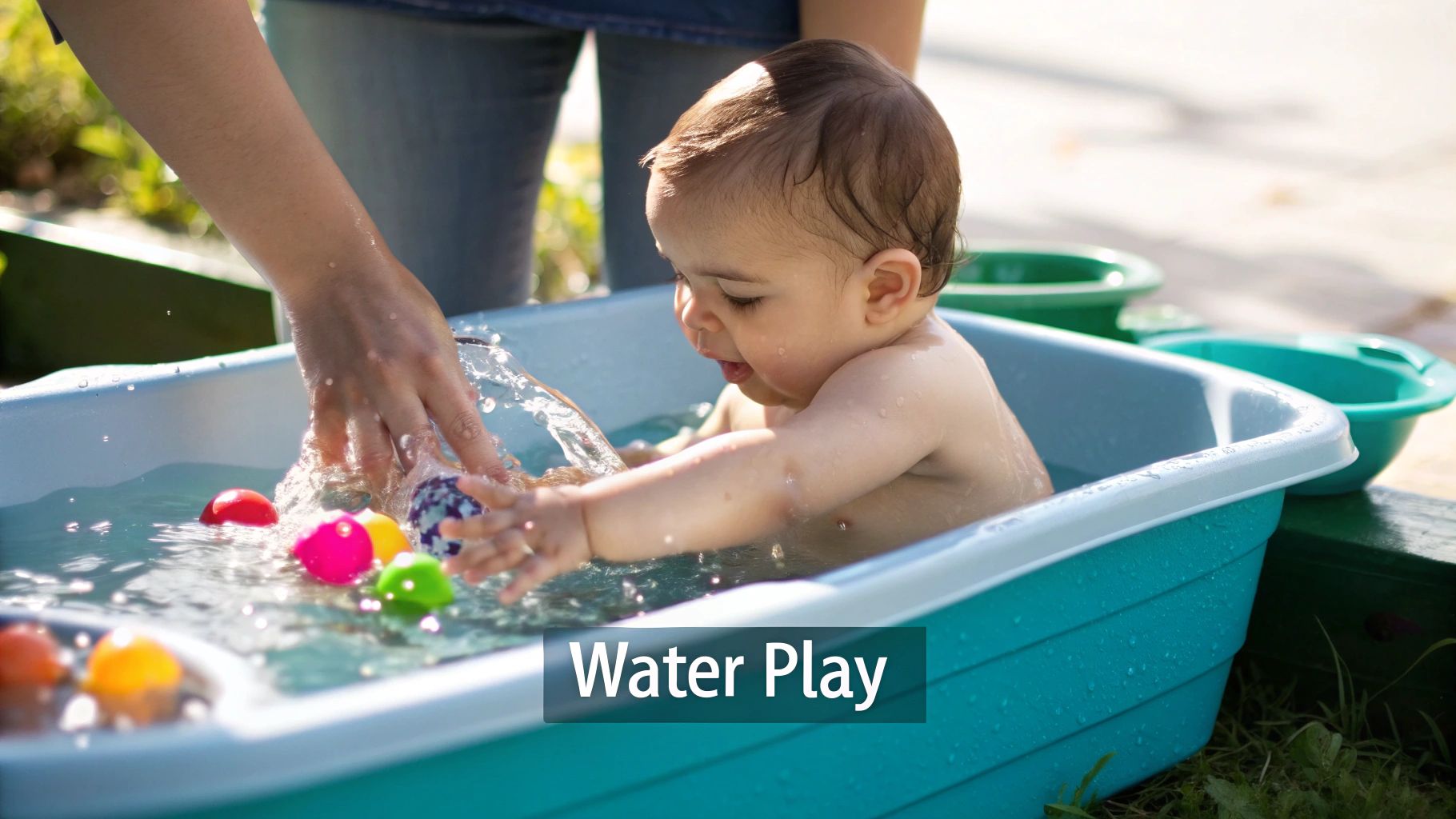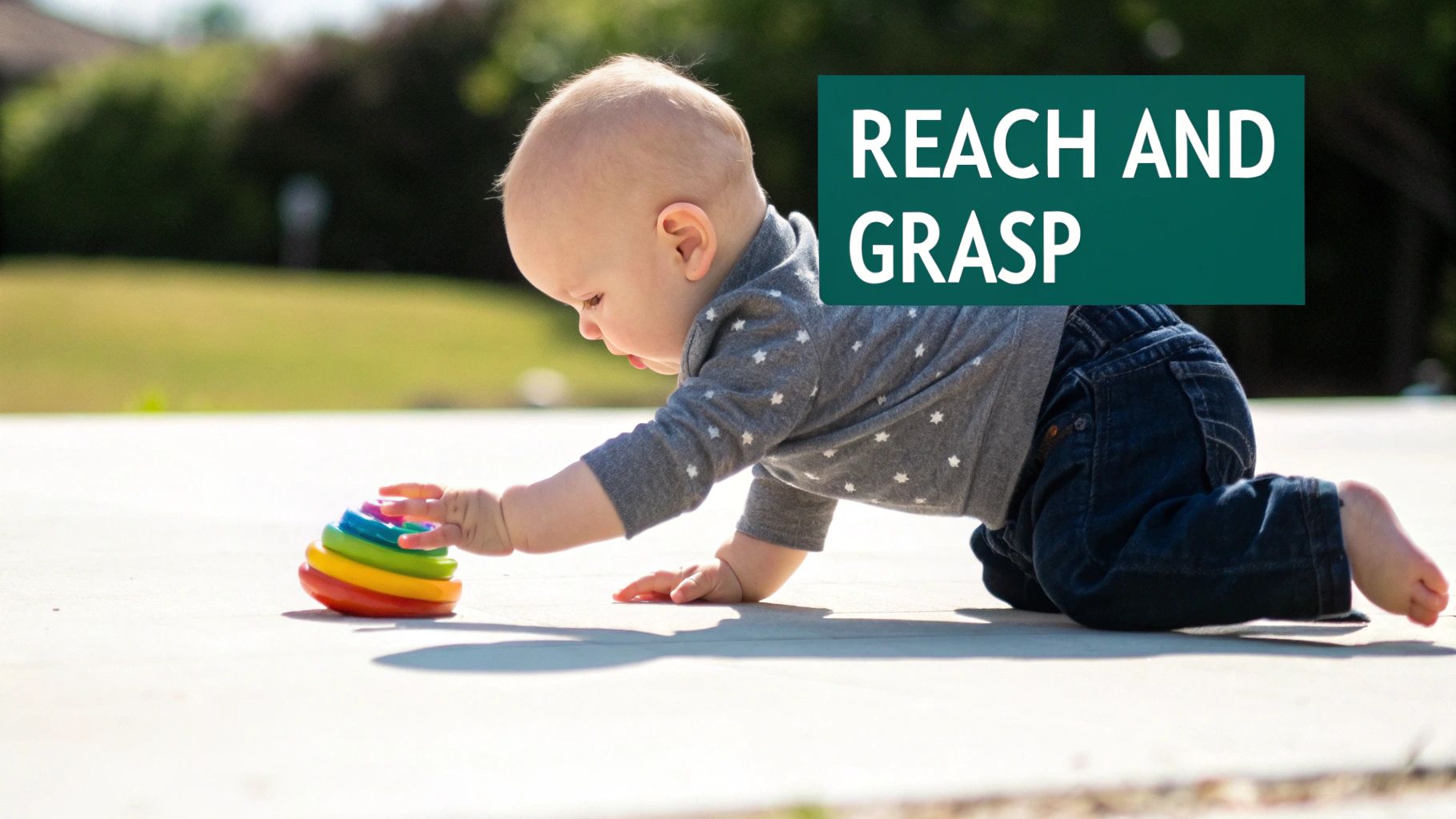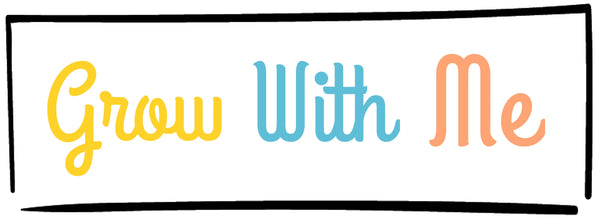
8 Engaging Activities for 6 Month Old Babies in 2025
Share
Six months marks a magical milestone in your baby's development. They're becoming more curious, interactive, and mobile, transforming from a passive newborn into an active little explorer. This is a crucial window for developmental growth, and the right activities can make all the difference. But what exactly should you be doing? Navigating the world of infant play can feel overwhelming, with endless advice and toy recommendations.
This guide cuts through the noise. We have curated a collection of simple yet powerful, developmentally appropriate activities for 6 month old babies, designed to stimulate their senses, strengthen their growing bodies, and build foundational cognitive skills. From enhancing motor control with tummy time to sparking early self-awareness with mirror play, these activities are your blueprint for meaningful interaction.
Each suggestion is straightforward, requiring minimal setup but offering maximum developmental benefit. We will break down how each activity supports your baby's learning, from fine-tuning motor skills to introducing early cause-and-effect concepts. Many of these foundational principles are applied in professional childcare settings, which offer inspiring activities in nurseries to spark joy and learning for infants. This list provides you with the tools to create that same enriching environment at home.
1. Tummy Time
While it may seem simple, Tummy Time is one of the most foundational activities for a 6 month old, providing the essential workout they need to build crucial physical skills. This supervised activity involves placing your baby on their stomach on a firm, flat surface. This position encourages them to lift their head and push up with their arms, strengthening the neck, shoulder, back, and core muscles that are vital for future milestones.
At six months, your baby is likely getting stronger and may even be starting to pivot or push themselves backwards during these sessions. Tummy time directly supports their ability to roll over, sit up independently, and eventually, to start crawling. It’s the groundwork for all gross motor development.

Making Tummy Time Engaging
To transform this essential exercise into a stimulating playtime, focus on creating an inviting environment. A dedicated corner with a colourful, textured play mat can make the experience more comfortable and exciting.
- Use Engaging Toys: Place a few favourite toys in an arc just out of reach to encourage your baby to pivot and stretch. A non-breakable, baby-safe mirror is also a fantastic tool; babies are fascinated by their own reflection, which can keep them happily engaged for longer.
- Sensory Exploration: Introduce different textures. A mat with crinkly sections, soft fabrics, or silky ribbons can add a sensory dimension to their workout.
- Get on Their Level: Lie down on the floor facing your baby. Your presence is the most interesting toy of all. Sing songs, make funny faces, and talk to them to provide encouragement and make it a bonding experience.
Top Tip: If your baby still fusses during tummy time, try shorter, more frequent sessions throughout the day. Even 3-5 minutes at a time, several times a day, will add up and provide significant benefits. You can also try placing a rolled-up towel under their chest and armpits for extra support.
2. Sensory Exploration with Textured Objects
At six months old, your baby is a tiny scientist, and their primary tools for discovery are their hands and mouth. Sensory exploration with textured objects is a powerful activity that capitalises on this natural curiosity. It involves introducing your baby to a variety of safe, touchable materials-like soft fabrics, bumpy balls, crinkly books, and smooth wooden toys-to stimulate their developing sense of touch. This tactile learning is fundamental for cognitive growth, helping your baby's brain form new connections as they process different sensory information.
This type of play is crucial among activities for a 6 month old because it lays the groundwork for fine motor skills and tactile awareness. As they grasp, squeeze, and mouth different objects, they learn about the world around them, differentiating between hard and soft, rough and smooth. For a deeper dive, understanding baby sensory development and how to stimulate their senses provides excellent insight into this crucial stage.

Making Sensory Exploration Engaging
Creating a multi-sensory experience is easier than it sounds. You can use specially designed toys or even safe household items to build a fascinating tactile playground for your little one. The key is variety and safety.
- Curate a Texture Basket: Gather a small collection of items with distinct textures. Include things like a Sassy Developmental Bumpy Ball, a soft velvet square, a crinkly fabric book, and a smooth, baby-safe wooden ring. Present two or three at a time to avoid overstimulation.
- Narrate the Experience: As your baby touches an object, describe it to them. Say things like, "That's a soft blanket," or "Feel the bumpy ball." This simple narration builds crucial language connections and helps them associate words with sensory feelings.
- Explore Beyond Toys: Safe household items can be wonderful sensory tools. A clean, silky scarf, a soft-bristled brush, or even a cool (not cold) metal spoon offer unique sensations under your careful supervision. For more inspiration, explore these sensory play ideas for babies.
Top Tip: Always supervise sensory play, as 6 month olds will inevitably explore objects with their mouths. Ensure all items are large enough not to be a choking hazard, are clean, and have no small, detachable parts. Rotate the items in your texture basket every few days to keep the experience fresh and exciting.
3. Baby Bouncing and Movement Games
Interactive movement games are a joyful and powerful way to engage with your 6 month old, combining physical stimulation, bonding, and sensory development in one fun-filled activity. This involves gently bouncing or moving your baby in rhythmic patterns, often paired with classic nursery rhymes or music. These simple movements are more than just play; they are crucial for your baby’s development.
At six months old, your baby’s balance and spatial awareness are rapidly developing. Bouncing and gentle swinging movements stimulate the vestibular system, which is located in the inner ear and is responsible for balance and coordination. This sensory input helps your baby understand where their body is in space, laying a foundation for future motor skills like sitting, crawling, and eventually walking.
Making Movement Games Engaging
Transforming simple bounces into a rich developmental activity is all about interaction and variety. Your enthusiasm and physical connection make these moments special and impactful for your little one.
- Incorporate Nursery Rhymes: Use classic songs that have actions built into them. Gently bounce your baby on your knees to the rhythm of "The Grand Old Duke of York" or rock them from side to side during "Row, Row, Row Your Boat." The predictable rhythm is comforting and helps with language development.
- Dance Together: Put on your favourite music and hold your baby securely while you dance around the room. Vary the tempo, from slow, gentle sways to more upbeat (but still gentle) bounces. This introduces them to rhythm and is a wonderful bonding experience.
- Explore Different Movements: Don't just stick to up-and-down bouncing. Try gentle swaying, circular motions, or lifting them up and down as if they are flying. Always ensure your movements are smooth and controlled.
Top Tip: Always ensure your baby’s head and neck are well-supported, especially during more dynamic movements. Watch for signs of overstimulation, such as crying or arching their back, and be ready to switch to a calmer activity. The key is to keep it fun and responsive to your baby’s cues.
4. Mirror Play and Self-Recognition
Mirror play is a captivating and powerful activity that boosts your baby’s cognitive development and social-emotional awareness. It involves providing a baby-safe, shatterproof mirror for your little one to gaze into. While they won't fully realise the reflection is their own just yet, this is the foundational stage where they begin to understand cause and effect by observing their own movements.
At six months, babies are fascinated by faces, and their own reflection is no exception. This simple yet profound interaction supports visual tracking, strengthens their focus, and lays the groundwork for self-recognition, which typically develops later. It’s one of the most engaging sensory activities for a 6 month old, helping them learn about their body and how it moves in space.
Making Mirror Play Engaging
To make mirror play an effective learning experience, it's all about placement and interaction. Integrating a mirror into different parts of their day can provide varied opportunities for discovery and fun.
- Integrate with Tummy Time: Place a floor mirror in front of your baby during tummy time. This can motivate them to lift their head and chest higher to get a better look, strengthening their neck and back muscles.
- Narrate and Point: Sit with your baby in front of the mirror and point to their reflection. Use simple language to name their body parts, like "Look, that's your nose!" or "You're waving your hands!" This helps build their vocabulary and body awareness.
- Use Expressive Faces: Make funny faces, smile widely, and sing songs while looking in the mirror together. Your baby will watch you and their own reflection, learning about emotions and social cues. This turns a simple activity into a rich, interactive bonding session.
Top Tip: Always ensure you are using an acrylic, shatterproof mirror designed specifically for babies. Securely mount wall mirrors at your baby's eye level in their play area or use toys with built-in mirrors, such as those found on play gyms or activity centres.
5. Water Play and Bath Time Activities
Transforming bath time into a sensory playground, supervised water play is a fantastic activity for a 6 month old. More than just a way to get clean, it offers a rich multi-sensory experience that stimulates their developing brain. This supervised activity involves exploring water with safe, age-appropriate toys, which helps your baby understand concepts like cause and effect (splashing makes waves) and temperature.
At six months, babies are becoming more interactive and curious about their surroundings. The unique environment of water provides a wonderful opportunity for them to develop fine motor skills as they grasp floating toys or try to scoop up water. It’s also an excellent way to strengthen the bond between you and your baby in a fun, relaxed setting.

Making Water Play Engaging
To make bath time a highlight of the day, introduce a variety of simple, safe, and stimulating elements that turn the tub into a mini-water park. Your focused interaction is key to making this a memorable learning experience.
- Introduce Fun Toys: Simple items like floating rubber ducks, colourful pouring cups, and waterproof books can provide endless entertainment. Foam letters that stick to the side of the bath can also be a fun way to introduce new shapes and textures.
- Encourage Splashing and Pouring: Show your baby how to splash gently with their hands or kick their feet. Guide their hands to hold a small cup, helping them scoop and pour water. This simple action is brilliant for developing hand-eye coordination.
- Sing and Talk: Narrate what you are doing, describing the feel of the water and the movement of the toys. Singing bath time songs like "Row, Row, Row Your Boat" or "Five Little Ducks" adds a joyful, auditory layer to the experience.
Top Tip: Safety is paramount. Never leave your baby unattended in or near water, not even for a second. Always test the water temperature with your elbow or wrist to ensure it is comfortably warm, not hot. Having a non-slip mat in the tub and all your supplies within arm's reach before you begin will ensure a safe and stress-free playtime.
6. Reaching and Grasping Exercises with Objects
Encouraging your baby to reach for and grasp objects is a fantastic activity that actively builds both their fine and gross motor skills. This simple exercise involves strategically placing safe, interesting items at varying distances to motivate your little one to extend their arms, coordinate their movements, and practice holding on. This is one of the most important activities for a 6 month old as it marks a key developmental leap from reflexive actions to purposeful, intentional movement.
At six months, babies are mastering the "raking grasp," using their whole hand and fingers like a rake to pull objects closer. They are also learning to deliberately transfer items from one hand to the other. These exercises strengthen their hand-eye coordination, finger dexterity, and understanding of cause and effect, laying the foundation for more complex skills like self-feeding and drawing later on.

Making Reaching and Grasping Engaging
The key to a successful grasping game is variety and encouragement. You can easily turn this into a fun, stimulating part of your daily routine using items you already have around the house.
- Vary the Objects: Offer a mix of toys to stimulate their senses. Soft balls, lightweight rattles, teething rings, and textured toys are all excellent choices. Ensure every object is safe to be mouthed and is too large to be a choking hazard.
- Strategic Placement: Start by placing an object within easy reach. Once they’ve grasped it, place the next one slightly further away to encourage stretching and movement. Placing toys at shoulder height is optimal for encouraging a good reach.
- Narrate and Celebrate: Talk your baby through their actions: "You're reaching so far for the red ball! You got it!" Your enthusiastic praise provides powerful motivation and helps build crucial language connections. For more ideas, you can explore other fine motor skills development activities.
Top Tip: Keep playtime interesting by rotating the objects you offer on a weekly basis. A simple wooden spoon or a colourful, crinkly scarf (used with close supervision) can be just as exciting as a brand-new toy. This novelty keeps them curious and eager to explore.
7. Music and Sound Exploration
Introducing your baby to a world of sound is a powerful activity that supports multiple areas of development, from cognitive skills to emotional expression. Music and sound exploration involves engaging your little one with different rhythms, melodies, and tones through singing, playing instruments, or listening to music. At six months old, a baby's auditory processing is rapidly advancing, and they are beginning to understand cause and effect, such as shaking a rattle to make a noise.
This sensory experience is a cornerstone of early learning. Engaging with music helps build neural pathways in the brain that are crucial for language acquisition and listening skills. It’s also a wonderful way to introduce concepts like rhythm and pattern, which are the early foundations of mathematical thinking. Furthermore, music is a fantastic tool for soothing, energising, and connecting with your baby.
Making Music and Sound Engaging
Transforming your living room into a concert hall for one is simple and incredibly rewarding. The goal is to create a multi-sensory experience that is both fun and developmentally stimulating.
- Introduce Simple Instruments: You don’t need a full band. Simple, age-appropriate instruments like maracas, soft-mallet xylophones, or baby-safe shakers are perfect. Show your baby how to hold them and make sounds, celebrating their efforts with cheers and smiles.
- Use Your Voice: Singing nursery rhymes is one of the best activities for a 6 month old. The repetitive melodies and predictable patterns in songs like 'Twinkle, Twinkle' or 'The Wheels on the Bus' are comforting and help build memory and language skills.
- Combine with Movement: Music is meant to be felt. Hold your baby and gently dance to different types of music, from classical to calm pop. Bounce them on your knee in time with a song to help them physically experience the rhythm.
Top Tip: Keep the volume of musical toys and recorded music at a conversational level to protect your baby's sensitive hearing. Mix live singing with recorded tracks to give them a variety of auditory experiences, and sing the same songs regularly to build comforting familiarity.
8. Cause-and-Effect Play with Interactive Toys
Exploring cause-and-effect is a monumental cognitive leap for your baby, and interactive toys are a fantastic way to introduce this concept. This type of play involves using toys that respond directly to your baby's actions, such as a button that plays music when pressed or a rattle that makes a sound when shaken. This immediate feedback helps your little one grasp a fundamental life lesson: "If I do this, then that happens."
At six months old, your baby is beginning to understand that they can influence their environment. Cause-and-effect play solidifies this crucial realisation, fostering cognitive development, problem-solving skills, and a sense of agency. It’s one of the most empowering activities for a 6 month old, showing them they have an impact on the world around them.
Making Cause-and-Effect Play Engaging
To maximise the learning potential, select toys with clear, immediate responses and create a supportive environment for discovery. The goal is to make it easy for your baby to connect their action with the toy’s reaction.
- Start with Simple Toys: Begin with toys that have a single, obvious function. A simple light-up rattle or a large, easy-to-press button that plays a sound is perfect. Classic pop-up toys where pressing a switch reveals a character are also excellent for this age.
- Demonstrate and Narrate: Show your baby how the toy works a few times, narrating the action. Say, “When you shake the rattle, it makes a noise!” or “You pressed the button and made the light turn on!” This verbal reinforcement helps cement the connection.
- Strategic Placement: Position the toy within your baby's easy reach while they are sitting (with support) or during tummy time. This allows them to explore independently without becoming frustrated. Read more about the benefits of interactive toys for babies to find the perfect fit for your little one.
Top Tip: Rotate interactive toys regularly to keep your baby engaged and curious. Balance time with electronic toys by also offering simple, non-electronic options like blocks or stacking rings to provide a well-rounded play experience and prevent overstimulation.
Comparison of 8 Activities for 6-Month-Olds
| Activity | Implementation Complexity 🔄 | Resource Requirements ⚡ | Expected Outcomes ⭐📊 | Ideal Use Cases 💡 | Key Advantages ⭐ |
|---|---|---|---|---|---|
| Tummy Time | Low–Medium: supervised, gradual progression 🔄 | Minimal: clean mat, occasional toys ⚡ | Strengthens neck/shoulder/core; reduces flat head; speeds motor milestones ⭐📊 | 2–6+ months; short repeated sessions during awake time 💡 | Prevents plagiocephaly; no-cost; foundational gross motor gains ⭐ |
| Sensory Exploration with Textured Objects | Low–Medium: requires safety vetting and rotation 🔄 | Low: assorted textured toys; hygiene & inspection ⚡ | Builds tactile pathways, fine motor skills, cognitive curiosity ⭐📊 | 6 months; short exploration bouts; rotate items to sustain interest 💡 | Cheap options; varied sensory input; supports hand-eye coordination ⭐ |
| Baby Bouncing and Movement Games | Medium: caregiver physical effort; monitor overstimulation 🔄 | Minimal: caregiver, optional music or safe space ⚡ | Vestibular/balance development; bonding; emotional regulation ⭐📊 | Soothing or active play; music/movement routines; caregiver-led sessions 💡 | Strong social bonding; calms fussy babies; encourages coordination ⭐ |
| Mirror Play and Self-Recognition | Low: secure installation and placement 🔄 | Low: shatterproof mirror, safe mounting hardware ⚡ | Early self-awareness; motivates movement; social-cognitive gains ⭐📊 | 4–6 months onward; complements tummy time and independent play 💡 | Inexpensive; sustained engagement; promotes self-recognition ⭐ |
| Water Play and Bath Time Activities | Medium–High: strict supervision and temperature control 🔄 | Moderate: warm water, bath toys, non-slip surface, safety prep ⚡ | Multisensory stimulation; motor skills; cause-and-effect learning ⭐📊 | Bath routines; brief supervised sessions; sensory-intro experiences 💡 | Enjoyable multisensory play; combines hygiene and learning ⭐ |
| Reaching and Grasping Exercises with Objects | Low: simple setup; careful object selection 🔄 | Low: safe objects of varying sizes/weights; rotation ⚡ | Improves hand-eye coordination; strengthens grasp; preludes pincer grasp ⭐📊 | 6 months; short targeted practice to extend reach distance 💡 | Uses everyday items; directly supports fine motor milestone progression ⭐ |
| Music and Sound Exploration | Low: control volume and avoid overstimulation 🔄 | Low–Moderate: instruments, recordings, live singing; battery care ⚡ | Enhances auditory processing; language and emotional regulation ⭐📊 | Routines, soothing moments, movement/music classes 💡 | Promotes language, rhythm, and bonding; calms babies ⭐ |
| Cause-and-Effect Play with Interactive Toys | Low–Medium: manage stimulation and battery maintenance 🔄 | Moderate: interactive toys, batteries, supervised placement ⚡ | Teaches cause-and-effect, problem-solving, agency; reinforces repetition ⭐📊 | Early cognitive play; short focused sessions; demonstration-led exploration 💡 | Highly engaging; motivates experimentation; builds early reasoning ⭐ |
Building a Foundation for Lifelong Learning
Navigating the world of baby development can feel overwhelming, but as we have explored, creating a rich learning environment for your six-month-old is all about embracing simple, joyful interactions. The activities outlined in this guide, from textured sensory exploration to engaging mirror play, are not just ways to pass the time; they are the fundamental building blocks of your baby's cognitive, physical, and emotional growth. Each game of peekaboo, every splash in the bath, and all the moments spent reaching for a colourful toy are powerful opportunities for connection and development.
The core takeaway is that a baby’s work is play. Through these carefully selected activities for a 6 month old, you are helping them make crucial neural connections. They are learning about cause and effect when they shake a rattle, developing motor control as they practice bouncing, and building self-awareness as they gaze at their reflection. These experiences, woven into your daily routine, lay an essential groundwork for more complex skills like problem-solving, language acquisition, and social interaction later on.
Key Principles for Playtime Success
Remember to prioritise these principles as you introduce new activities:
- Follow Your Baby’s Lead: Your little one is the best guide. Pay close attention to their cues of interest, excitement, or tiredness. A successful play session is one that respects their pace and preferences, not one that checks off a list.
- Consistency Over Complexity: You do not need elaborate setups or expensive equipment. The real magic happens through consistent, repeated engagement. A few minutes of focused tummy time or singing a song each day has a far greater impact than a one-off, complicated activity.
- Celebrate Small Victories: Every wobbly grasp, gurgle of delight, and moment of focused attention is a significant milestone. Acknowledge and celebrate these achievements with smiles and encouragement to build their confidence and make learning a positive experience.
Ultimately, your engaged and loving presence is the most important developmental tool your baby has. By incorporating these varied sensory, motor, and cognitive activities for a 6 month old, you are not just entertaining them; you are actively shaping their understanding of the world. You are nurturing their innate curiosity and building a secure, loving foundation from which they will continue to learn and grow for a lifetime. Enjoy this beautiful and fleeting stage of discovery together.
Ready to take the guesswork out of playtime? Let Grow With Me deliver the perfect, expert-curated developmental toys for your baby's exact stage, right to your door. Explore our play kits and make every moment a meaningful learning opportunity. Grow With Me
